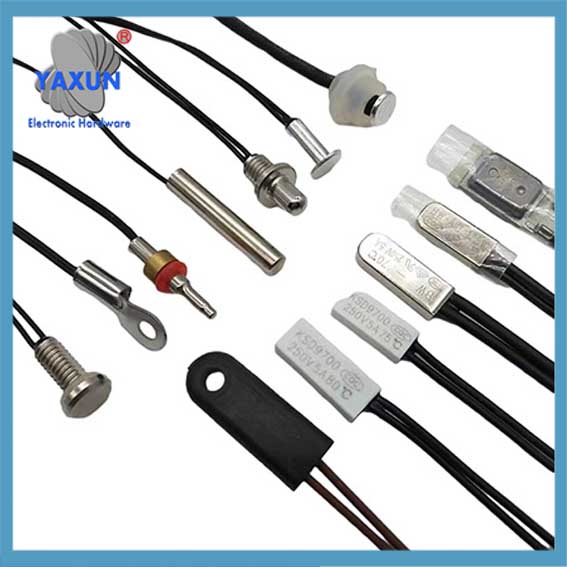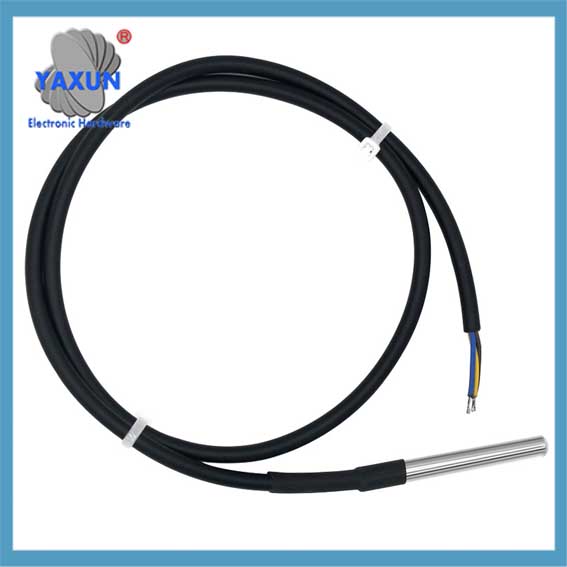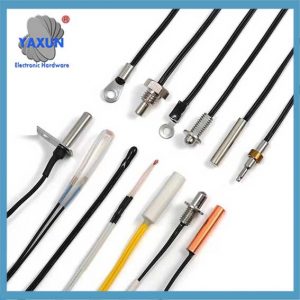产品类别
产品标签
温度探头, 温度传感器类型 & 应用
温度探头是一种用于测量温度的装置, 通常由敏感元件和测量电路组成. 敏感元件可以是热电偶 (100分, 1000 分), 热电阻 (NTC, 正温度系数), 半导体 (DS18B20数字), ETC。, 它可以将温度变化转换成电信号. 然后就被放大了, 过滤的, 转换的, 并由测量电路处理, 最后输出与温度成正比的电信号.
温度探针和温度传感器是两个不同的设备, 他们在测量温度时具有自己的特征和应用方案.
温度探针
A “温度探针” 是通过将热能转换为可测量的电信号来测量温度的传感器, 探针中最常见的温度传感器类型包括热电偶, 电阻温度探测器 (RTD), 和热敏电阻, 每个都基于所需的准确性具有独特的特征和应用, 温度范围, 和特定情况所需的响应时间.
定义: 温度探头是一种用于测量温度的装置, 通常由敏感元件和测量电路组成. 敏感元件可以是热电偶 (100分, 1000 分), 热电阻 (NTC, 正温度系数), 半导体 (DS18B20数字), ETC。, 它可以将温度变化转换成电信号. 然后就被放大了, 过滤的, 转换的, 并由测量电路处理, 最后输出与温度成正比的电信号.
工程原理: 温度探针的工作原理是使用敏感元件对温度变化的响应,以将温度变化转化为电信号. 常见的敏感元素包括热电偶, 热电阻, 半导体, ETC. 热电偶的工作原理是使用两种不同金属或合金的热电效应. 当它们连接在一起并在不同的温度下, 与温度成比例的电动力. 热电阻的工作原理是使用金属或半导体材料的电阻随温度变化的特性. 当温度变化时, 电阻价值也将相应改变. 半导体的工作原理是使用半导体材料的电导率随温度变化的特性. 当温度变化时, 电导率也将相应改变.
类型: 温度探针的类型主要包括热电偶探针, 热电阻探针, 半导体探针, ETC. 热电偶探针使用热电偶作为敏感元素, 并具有广泛测量范围的特征, 响应速度快, 和高精度. 热电阻探针使用热电阻作为敏感元件, 并具有高测量精度的特征, 稳定性好, 和强大的抗干扰能力. 半导体探针使用半导体作为敏感元素, 并具有小规模的特征, 轻的, 和低功耗.
申请字段: 温度探针广泛用于行业, 科学研究, 医疗保健, 环境保护和其他领域. 例如化学的温度测量和控制, 石油, 冶金, 电, 药物, 食品和其他行业.
DS18B20温度传感器电缆带探针
接线: 红色的(电压控制电路), 黄色的(数据), 黑色的(接地)
宽温度范围 -55 ℃~ +125 ℃
电源: 3.0V〜5.5V
尖端: 在数据和VCC之间使用4.7K的电阻将使探头更轻松地测试.
热电偶:
功能: 根据两条不同金属线的连接处的温度产生电压差.
优点: 温度范围宽 (-200°C至1750°C), 相对便宜, 快速响应时间.
缺点: 与其他传感器相比,精度较低, 需要校准表将电压转换为温度.
应用领域: 高温应用等熔炉, 发动机监控, 工业过程.
热敏电阻:
温度探针的应用:
工业过程: 监测烤箱等制造过程中的温度, 反应堆, 和挤出机.
HVAC系统: 通过监测空气温度来调节建筑物中的室温.
食品安全: 在烹饪和储存过程中监测食品温度以确保食品安全.
医疗设备: 通过插入体内的探针测量患者的体温.
汽车行业: 监视发动机冷却液温度和机舱温度.
科学研究: 实验中的精确温度测量.
温度感应器
定义: 温度传感器是可以将温度变化转换为电信号的设备. 它通常由敏感元素和信号处理电路组成. 敏感元件可以是热电偶, 热电阻, 半导体, ETC. 信号处理电路可以是模拟电路, 数字电路, ETC。, 共同完成收购, 温度信号的处理和输出.
工程原理: 温度传感器的工作原理与温度探针的工作原理相似. 它还使用敏感元件对温度变化的响应将温度变化转换为电信号. 然而, 温度传感器通常具有更复杂的信号处理电路, 可以在温度信号上执行更高级的处理, 例如数字转换, 数据存储, 沟通, ETC.
类型: 温度传感器的类型主要包括模拟温度传感器, 数字温度传感器, 和智能温度传感器. 模拟温度传感器输出模拟信号, 需要通过模数转换器将其转换为数字信号. 数字温度传感器直接输出数字信号, 并具有强大的抗干扰能力的特征, 高精准度, 和简单的整合. 智能温度传感器具有诸如自我诊断之类的功能, 自我校准, 和沟通, 并可以实现远程监视和控制.
特征: 温度传感器具有高测量精度的特征, 稳定性好, 抗干扰能力强, 和简单的整合. 不同类型的温度传感器具有不同的特征, 例如模拟温度传感器需要模数转换器, 数字温度传感器直接输出数字信号, 智能温度传感器具有诸如自我诊断之类的功能, 自我校准, 和沟通.
申请字段: 温度传感器广泛用于智能家居, 智能可穿戴, 医疗设备, 工业自动化, 环境监测和其他领域, 比如空调, 冰箱, 洗衣机, 温度计, 血压计, 工业控制系统, ETC.
如何选择?
选择温度探针或温度传感器时, 需要考虑以下因素:
申请环境: 考虑测得的环境是否具有特殊条件,例如腐蚀性, 高温, 高压, ETC。, 以选择合适的材料和保护水平.
测量范围: 根据要测量的温度范围选择合适的传感器,以确保传感器可以准确测量所需范围内.
准确要求: 根据适用于温度测量的应用的准确性要求,选择具有相应精度的传感器.
成本预算: 根据预算限制选择具有成本效益的传感器.
如何使用?
当使用温度探针或温度传感器时, 需要注意以下问题:
安装: 根据传感器的安装说明正确安装它,以确保传感器与要测量的对象保持良好接触,并避免由不当安装引起的测量错误.
接线: 正确连接传感器的信号线和电源线,以确保信号传输的稳定性和准确性.
校准: 定期校准传感器,以确保其测量精度满足应用要求.
维护: 定期清洁并维护传感器以避免灰尘, 污垢, ETC. 影响传感器的测量性能.
温度探针传感器是我们YXAUN公司的重要产品之一. 我们专注于智能制造和工业自动化领域, 并提供一系列高精度和稳定的测量和控制设备, 包括温度探针传感器. 我们的温度探针传感器广泛用于工业制造, 环境监测, 能源管理和其他行业高精度, 稳定性和对复杂环境的适应性. 如果您对我们的温度探测传感器有特定的需求或疑问, 请随时咨询我们. 我们将全心全意为您提供专业的答案和服务. 您想知道温度探针传感器的哪个方面?
如何选择合适的温度探针传感器?
选择温度探针传感器时, 考虑温度测量范围, 精度要求, 响应速度和安装环境. 例如, 可以在工业环境中选择热电偶或铂抗性, PT100高精度, 和热电偶快速响应.
联系我们
等待您的电子邮件, 我们将在短时间内回复您 12 小时提供您需要的有价值的信息.
 English
English Afrikaans
Afrikaans العربية
العربية বাংলা
বাংলা bosanski jezik
bosanski jezik Български
Български Català
Català 粤语
粤语 中文(简体)
中文(简体) 中文(漢字)
中文(漢字) Hrvatski
Hrvatski Čeština
Čeština Nederlands
Nederlands Eesti keel
Eesti keel Suomi
Suomi Français
Français Deutsch
Deutsch Ελληνικά
Ελληνικά हिन्दी; हिंदी
हिन्दी; हिंदी Magyar
Magyar Bahasa Indonesia
Bahasa Indonesia Italiano
Italiano 日本語
日本語 한국어
한국어 Latviešu valoda
Latviešu valoda Lietuvių kalba
Lietuvių kalba македонски јазик
македонски јазик Bahasa Melayu
Bahasa Melayu Norsk
Norsk پارسی
پارسی Polski
Polski Português
Português Română
Română Русский
Русский Cрпски језик
Cрпски језик Slovenčina
Slovenčina Slovenščina
Slovenščina Español
Español Svenska
Svenska ภาษาไทย
ภาษาไทย Türkçe
Türkçe Українська
Українська اردو
اردو Tiếng Việt
Tiếng Việt












